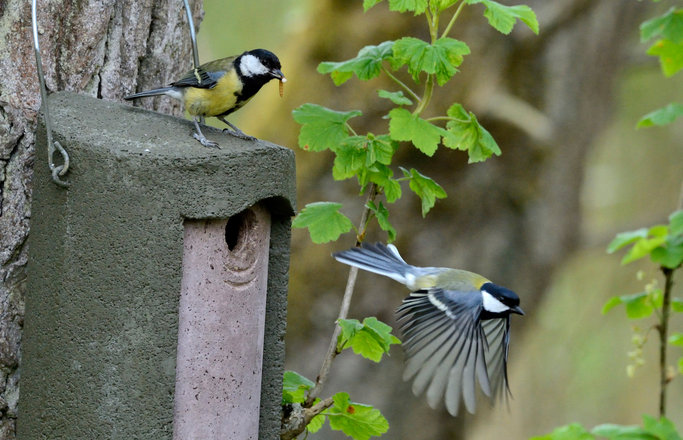
Nest Boxes - FAQ
Is my garden suitable for nest boxes?
All gardens can offer nest boxes for small birds. Even the tiniest gardens should have a box or two, and the larger your garden the more you can provide and the greater the variety of birds you will attract.
Should I make a nest box…?
Millions of broods of birds have been reared in Britain in home-made nest boxes knocked together from spare wood. Designs are legion. For tits, the thickness of the wood (at least 15mm) and the internal size of the base (at least 11.5 x 11.5 cm or 4.5 x 4.5 inches) are important. Don’t include a perch: birds don’t need one, and it may act as a foothold for squirrels or weasels as they try to reach inside the box to grab eggs or chicks. A good box should give easy access for human observers who wish to record the contents and simplifies cleaning out disused nesting materials at the end of the season.
For good designs and instructions visit www.nestboxweek.com.
…Or should I buy one?
Before making your own box, it’s wise to first consider the considerable advantages of Schwegler nest boxes made from woodcrete, a unique combination of sawdust and concrete. Birds are more likely to choose them and more likely to nest successfully in them. The excellent thermal properties of woodcrete keep birds warm in cold weather and cool when it’s hot, and ensure lower condensation inside the box. Materials without these properties — especially plastics, ceramics, thin wood and ply — make poor, even dangerous, nest boxes.
Schwegler nest boxes are rot-proof, predator-proof and extremely long-lasting. Although they can cost up to twice as much as ready-made wooden boxes, they often last ten times as long.

What size entrance hole is best?
This is an easy question to answer. Any bird in a nest box is good news - so a 32mm hole is the right choice for most boxes since it is a perfectly acceptable size for all tits and for nuthatches and tree sparrows. If you specifically want to encourage house sparrows, or are lucky enough to have redstarts around, try a 29 x 55mm oval hole.
Where should I position it?
Most birds are not too fussy. Fixing on trees, walls and fences at about 1.7m (5’6”) is fine. If you’re putting up several boxes you can vary the height upwards if you wish. Free-hanging boxes should be fixed above 2m (6’6”) if they might otherwise be a hazard to your head. In an open location, it’s generally best if the hole faces south-east to avoid the worst of the weather. Ideally it shouldn’t be in direct sunlight (but this is not so important with Schwegler boxes since they are so well insulated). Having adjacent boxes facing in opposite directions may reduce unfriendly interactions between the birds. Avoid places where cats can climb up or leap across to the box, and if squirrels are a likely problem a wall may be better than a tree. Never put boxes close to bird feeders and bird tables since feeding birds will be seen as a threat by the nesting birds.
How many should I put up?
In a medium-sized garden in which natural holes are in short supply, it’s worth putting up 4 or 5 boxes. If you find all your boxes are occupied, put up more to ensure there are always spare homes available.
Should I include Open-fronted boxes too?
These are well worth trying but don’t expect quick results. Too little is known about exactly what birds are seeking. And of course, there are many different aspects to open-fronted boxes whereas the overwhelming attraction for tits is simply the hole! Fix your open-fronted box on a wall at 1.8m (6’) for Robins and higher for Spotted Flycatchers. Partially conceal it behind a climbing plant if possible. Where predators might be a danger choose a design which is long and deep so birds build their nests at the rear.
Should I clean out my nest boxes each year?
The presence of old nest material won’t stop birds re-using a box- afterall, natural nest cavities aren’t cleaned out each year. However, removing old nests reduces the numbers of parasites like fleas, lice and ticks. By law boxes can only be cleaned out between 1st August and 31st January. It is advisable to wear gloves and a dust mask and dispose of old nests straight away.
What birds might I attract with different nest box designs?
Depending on the bird species in your area, and the design and quality of the nest boxes you put up, you may well be successful in homing house martins, swallows, swifts, starlings, wrens and spotted flycatchers.


